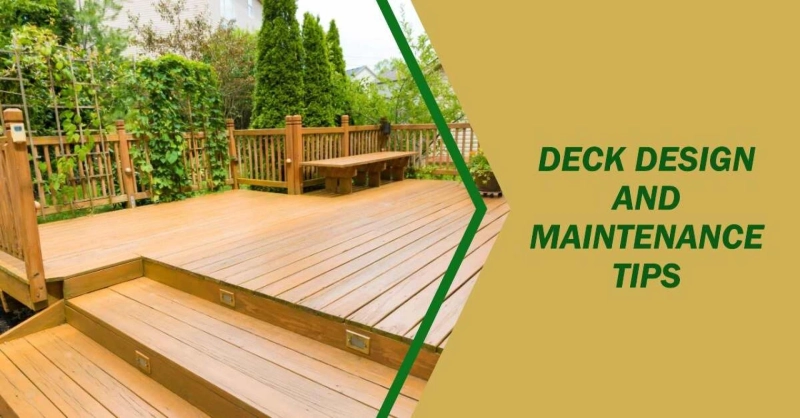Timber decks are not just functional extensions of your living space; they are also a reflection of your style and a gateway to the outdoors. Whether you're seeking timber information for a new deck project or rejuvenating an existing one, the design and maintenance aspects are crucial for ensuring your deck remains a stunning asset. In this comprehensive guide, we'll delve into the world of timber deck design, providing you with inspiration, practical tips, and insights into maintenance that will keep your outdoor space a beautiful sanctuary for years to come.
Designing Your Timber Deck
1. Purpose and Functionality
Before delving into design details, it's essential to clarify the purpose of your deck. Are you looking for an entertainment area, a cozy retreat, or an outdoor dining space? Determining its functionality will guide your design choices.
2. Deck Size and Layout
The size and layout of your deck should harmonize with your home's architecture and the available space. Consider the flow of traffic, access points, and the balance between open areas and shaded zones.
3. Timber Selection
Choosing the right timber is a cornerstone of your deck's design. Popular choices like cedar, redwood, and treated pine offer durability and aesthetics. The timber's color, grain, and resistance to decay should align with your design vision and local climate.
4. Railing and Balustrades
The choice of railing and balustrades can dramatically impact your deck's appearance. Opt for materials and styles that complement your home and the surrounding landscape. Glass balustrades, for instance, provide unobstructed views, while timber railings create a classic look.
5. Decking Patterns
Experimenting with decking patterns can add character to your deck. Herringbone, chevron, or picture frame patterns can elevate the aesthetics. Keep in mind that complex patterns may require more maintenance.
6. Built-in Features
Consider built-in features like benches, planters, or pergolas. These not only enhance functionality but also contribute to the overall design. They're excellent for creating defined zones within your deck.
7. Lighting
Lighting is both a design element and a safety feature. Incorporate deck lighting to create ambiance and ensure your deck remains usable after dark. LED strip lighting, solar-powered fixtures, and recessed lighting are popular choices.
8. Color Scheme
Select a color scheme that complements your home's exterior. Timber can be stained or painted in various hues to achieve the desired effect. Earthy tones are a timeless choice, while bold colors can make a statement.
Maintaining Your Timber Deck
1. Regular Cleaning
Timber decks are exposed to the elements, which can lead to the buildup of dirt, algae, and mold. Regular cleaning with a deck cleaner and a soft brush will help preserve its appearance. Consider pressure washing for deep cleaning, but use it cautiously to avoid damage.
2. Staining and Sealing
Staining and sealing your deck not only enhance its beauty but also protect it from moisture and UV damage. Choose a quality deck stain or sealant suitable for your timber type. The frequency of staining depends on your climate; in general, it's recommended every 1-3 years.
3. Inspection and Repairs
Frequent inspections are essential for identifying loose boards, popped nails, or damaged sections. Prompt repairs prevent minor issues from escalating into costly problems. Check for rot or termite damage, particularly in ground-level decks.
4. Pest Control
Timber decks can attract pests like termites and carpenter ants. Consider regular pest control measures to protect your investment. Consult with a professional if you suspect an infestation.
5. Avoiding Water Accumulation
Water pooling can be detrimental to timber decks. Ensure proper drainage and ventilation to prevent moisture buildup. Use quality flashing where the deck attaches to the house to avoid water infiltration.
6. Sanding and Refinishing
Over time, your deck may show signs of wear, including splinters and rough patches. Sanding and refinishing can breathe new life into your deck's appearance. It's an opportunity to try a different stain or finish for a fresh look.
7. Seasonal Care
Timber decks may expand and contract with seasonal changes. Be mindful of these shifts and provide adequate spacing between boards during installation. Adjust for humidity and temperature variations to prevent warping or cracking.
Conclusion: A Timber Deck to Cherish
A stunning timber deck is not only a testament to your design prowess but also a space where cherished memories are created. By meticulously planning its design and dedicating yourself to regular maintenance, you can ensure that your outdoor haven remains a beautiful and functional extension of your home. The key is to approach your deck as a long-term investment and an ongoing labor of love. With the right care, your timber deck will continue to be a source of pride and joy for years to come.


